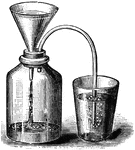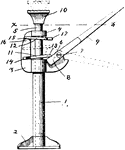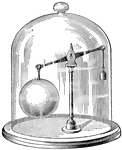Piston and Rod
"A piston and rod shown with attached weight. The valve, A, can be opened and closed as needed so that…
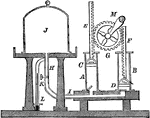
Double Barrel Air Pump
"Crank M raises and lowers the two pistons C and D. The valves allow only for air to be removed from…

Mechanical Action Air Pump
A pump is a device used to move fluids, such as liquids or slurries, or gases. A pump displaces a volume…
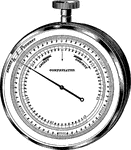
Aneroid Barometer
"The principal part of the aneroid barometer is a cylindrical air-tight box of metal closed by a corrugated…

Aneroid Barometer
This barometer depends upon the changes in form of a think metallic vessel partially exhausted of air,…

Archimedes Principle
"From on pan suspend a hollow cylinder of metal t, and below that a solid cylinder a of the same size…
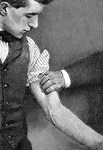
Branchial artery
"Showing how firm pressure may be made with the fingers to compress the branchial artery of the left…
Atmospheric Pressure
"The pressure of the atmosphere may be easily shown by the tube and piston. suppose there is an orifice…
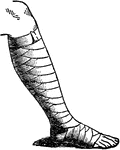
Roller Bandage
"Roller Bandage. Bandage, a surgical wrapper of some kind applied to a limb or other portion of the…
Barometer
"A Torricellian tube, firmly fixed to an upright support and properly graduated, constitutes a mercurial…
Barometer
"The barometer is simply a pressure gauge that registers the pressure of the air. In this case the cup…
Barometer
"Suppose a to be a long tube, with the piston b so nicely fitted to its inside, as to work air tight.…

Barometer
A standard mercury barometer has a glass column of about 30 inches in height, closed at one end, with…

Barometer
"...being merely a tube of glass, nearly filled with mercury, with its lower end placed in a dish of…
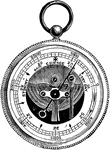
Aneroid barometer
"The aneroid barometer is an easily portable instrument, and avoids the use of any liquid. It consists…

Mercury Barometer
"Mercury enclosed in a tube inverted and inserted into a bath of mercury can serve as a measurement…
Barometer Measuring Pressure of a Partially Evacuated Vessel
"The degree to which the air has been exhausted from a closed vessel in which there is a partial vacuum…

Blake Ore Breaker
This illustration shows a Blake Ore Breaker (stone crusher), used in a gold stamp mill. This crusher…

Buttress of Blocks
Uniting the theories of partial polygons of resistance and centres and lines of resistance, this buttress…
Proof of Boyle's Law for Expanding Air
This apparatus is used to prove Boyle's Law which describes the relationship between the product pressure…
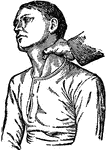
Carotid compression
"The carotid artery may be compressed by pressing the thumb or fingers deeply into the neck in front…

Compressed Air Manometer
This instrument consists of a bent tube closed at one end and containing within the space a quantity…

Steam and Water Cooker
Pressure cooking is a method of cooking in a sealed vessel that does not permit air or liquids to escape…

Dust Storm
A storm composed of sand. It occurs when the air over the sand becomes hot, and rises. The differences…
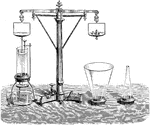
Experiment of Pascal's Values
The pressure on the bottom of a vessel containing liquid is not affected by the breadth or narrowness…

Forcing-Pump
"In the forcing-pump atmospheric pressure plays but a small part. There is no valve in the piston c,…
!["For measuring the gas concentration, pressure and temperature, use may be made of an apparatus of the type shown [here]." —The Encyclopedia Britannica 1910](https://etc.usf.edu/clipart/36100/36102/app_gas_36102_mth.gif)
Apparatus for Measuring Gas Concentration Pressure and Temperature
"For measuring the gas concentration, pressure and temperature, use may be made of an apparatus of the…
McLeod Gauge
A McLeod gauge isolates a sample of gas and compresses it in a modified mercury manometer until the…
McLeod Gauge
A McLeod gauge isolates a sample of gas and compresses it in a modified mercury manometer until the…

Hydraulic Water Ram
"The hydraulic ram uses alternating water pressure, air pressure, and suction to provide a steady stream…

Hydraulic Ram
"Pumps water in bursts. Water enters pipe B and is forced into D then up the tube F. Any excess water…
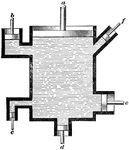
Hydromechanics
Water that is placed in an apparatus will have equal pressure if the pistons pushing on it push at the…
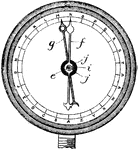
Pressure Variation Indicator
To monitor breathing gas pressure in the diving cylinder, a diving regulator usually has a high pressure…

Pascal's Law
An image summarizing Pascal's law, which states that pressure of a liquid is equal in all directions…
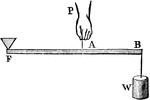
Third Kind of Lever
"In the third order of lever the power acts between the prop and the resistance, where also P : W ::…
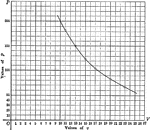
Logarithmic Graph of the Law of Expansion
Logarithmic graph (smooth curve) modeling the law of expansion with values of volume and pressure.

Magdeburg Hemispheres
"By means of the two hemispheres, it can be proved that the atmosphere presses upon a body equally in…
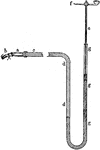
Manometer
"Mercury manometer for recording blood-pressure. d g, glass U-tube partly filled with mercury. In one…

Mountain Rupture
"Rupture of a Mountain.—There is no doubt, but in the operations of nature, great effects are…

Oblique Rays
The vertical rays are spread over a smaller area, and pass through a thinner layer of air. The vertical…
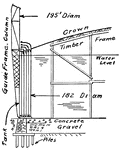
Partial Section of Typical Large American Gas Holder
A gas holder is a metallic shell which is open at the bottom (like a bell), the lower edge of which…
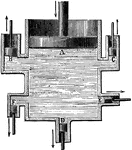
Pascal's Law
"Pressure exerted anywhere upon a liquid inclosed in a vessel is transmitted undiminished in all direction,…
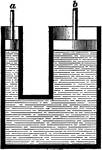
Pascal's Law and Water Pressure
"...let the area of the piston a be 1 square inch; of b, 40 square inches. According to Pascal's law,…

Pressure of Liquids
"The tightly fitted piston at the top of a glass vessel of water is driven down. The contained liquid…

Downward Pressure
In image a, the pressure at the bottom is the same as the pressure at the top of the cylinder. If the…

Upward Pressure
No upward pressure is present on surface c because of because of the weight of the water in part c d.…
!["Get a lamp-chimney, preferably cylindrical. With a diamond or a steel glass-cutter, cut a disk of window glass a little larger than the cross-section of the lamp-chimney. Pour some fine emery powder on the disk, and rub one end of the chimney upon it, thus grinding them until they fit accurately...place [the chimney] under the water as shown. the upward pressure of the water will hold the disk in place. Pour water carefully into the tube; the disk will fall as soon as the weight of the water in the chimney plus the weight of th disk, exceeds the upward pressure of the water." -Avery 1895](https://etc.usf.edu/clipart/35900/35965/water_press_35965_mth.gif)
Water Pressure Experiment
"Get a lamp-chimney, preferably cylindrical. With a diamond or a steel glass-cutter, cut a disk of window…
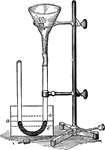
Effects of Water on Mercury in a U-tube
"After pouring mercury into the U-tube, the level of mercury is marked by a. c and e refer to the positions…

Water Pressure Independent of Vessel
"By measuring the weight required to move the end cap of any of the shown tubes filled with water, it…

Water versus Wood Pressure
"The vessel a is fitted with a wooden bock of the same size as, and free to move in, the cylinder; the…



